History of Petrozavodsk
Foundation of Petrozavodsk
The history of Petrozavodsk began in 1703, when, by order of Peter I, the Shuisky state-owned metallurgical and arms plant was founded on the shore of Lake Onega. The site for the new plant was chosen by a special expedition in 1702, in the area known for its deposits of copper and iron ore. Here it was decided to set up a plant for the production of cannons and other military equipment needed by the Russian army during the Great Northern War (1700-1721), since delivery from factories located in the Urals was very long and expensive.
The territory of the Shuisky plant was surrounded by an earthen rampart, on which cannons were placed. Six artillery batteries were served by a special garrison. So the plant was turned into a fortress that could stand up for itself in the event of a Swedish attack. By the time the construction was completed, the plant was renamed in honor of Peter I to Petrovsky. The plant also became the beginning of the formation of the settlement of workers named Petrovskaya sloboda (village).
At the beginning of 1704, four blast furnaces were operating at full capacity, a pier was built to ship cannons and cannonballs. Soon, this arms plant became the largest enterprise of Russia. With the development of the plant, Petrovskaya sloboda also expanded. Up to 800 people worked at the plant every day. In 1717, about 3,000 people were already permanently living in the village.
In 1721, the Great Northern War ended with the victory of the anti-Swedish coalition. The borders of Russia expanded due to the annexation of part of the Swedish territory, the need for cannons decreased. A lot of craftsmen from the Petrovsky plant left for Yekaterinburg (also founded as a plant in 1723), and the plant itself switched to the production of tin, nails, fountain pipes, wire, cast-iron fences, parts of bridges for St. Petersburg, anchors for the Baltic Fleet. In 1734, the main production at the Petrovsky plant was closed. For several decades, life in Petrovskaya sloboda quieted down.
More Historical Facts…
Petrozavodsk in the late 18th - early 20th centuries
In September 1772, Empress Catherine II signed a decree on the construction of a new cannon foundry (the Aleksandrovsky plant) - the best plant in the Russian Empire of its time in terms of technical equipment, technology level, and product quality. In 1777, she renamed Petrovskaya sloboda to the district town of Petrozavodsk (literally “Peter’s plant”). In May 1784, Petrozavodsk became a regional center.
In 1798, the Aleksandrovsky plant was given the exclusive right to manufacture volumetric measures (weights, scales, steelyards), on which a “secret stamp” was placed in order to avoid forgeries.
During the French invasion of Russia (1812), part of the treasures of the Imperial Academy of Arts and the Russian National Library were evacuated from St. Petersburg to Petrozavodsk. In 1858, about 10 thousand people lived in the town. In 1860, a passenger steamship service was opened between Petrozavodsk and St. Petersburg.
In October 1910, the town’s hydroelectric power plant with an eight-meter dam was put into operation - one of the largest urban hydroelectric power plants in the Russian Empire. In 1914, the population of Petrozavodsk was about 16,400 people. The Murmansk railway passed through the town in 1915.
Petrozavodsk before and after the Second World War
In the 1920s-1930s, Finnish immigrants made a great contribution to the development of Petrozavodsk. Their knowledge and experience were in demand at all major construction sites of that time. On October 22, 1932, the opening of the Finnish Drama Theater took place. Until 1937, the Finnish language in Karelia was the second state language after Russian. The Finns also played an important role in the cultural, scientific, and educational life of Petrozavodsk and the whole republic. In 1939, the population of the city was 69,723 people.
On October 2, 1941, during the Second World War, Petrozavodsk was occupied by the Finnish Karelian army and renamed Aanislinna. On October 14, 1941, the first Finnish concentration camp was formed in Petrozavodsk, in which Russian men born in 1891-1924 were subject to imprisonment. In total, 11 concentration camps were created on the territory of the city and nearby villages. On June 28, 1944, Petrozavodsk was liberated by Soviet troops.
After the war, the badly destroyed Petrozavodsk was rebuilt as an exemplary Soviet city. The characteristic groups of Soviet buildings of many streets have survived to this day. In 1955, the construction of new buildings for the railway station and the State Music and Drama Theater of the Karelo-Finnish SSR was completed, in 1965 - for the Finnish Drama Theater. In 1956, the population of Petrozavodsk was about 118 thousand people.
The largest housing construction and infrastructure development took place in the 1970s and early 1980s. Then five new residential neighborhoods were created in Petrozavodsk. A lot of kindergartens, schools, the hotel “Karelia”, the movie theater “Kalevala”, the river station, and the Tomb of the Unknown Soldier memorial were built.
In 1991, the population of Petrozavodsk was about 277 thousand people. Unlike many other cities in Russia, its population did not decrease significantly after the collapse of the USSR; it remained at about the same level.
April 6, 2015, Petrozavodsk was awarded the honorary title of the Russian Federation - The City of Military Glory.
Pictures of Petrozavodsk
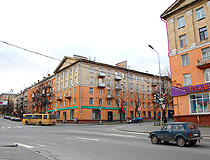
On the street in Petrozavodsk
Author: Nikitin Sergey
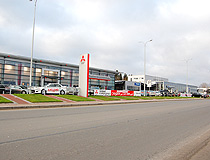
Car dealer in Petrozavodsk
Author: Nikitin Sergey
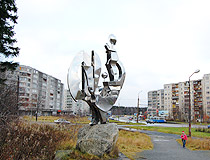
Rooster sculpture in Petrozavodsk
Author: Nikitin Sergey
Petrozavodsk - Features
Petrozavodsk occupies an advantageous geographical position. Through Lake Onega and canals, the city has access to the Baltic, White, Barents, Caspian, and Black seas. It is located near the federal cities of Russia, 1,020 km north of Moscow and 430 km northeast of St. Petersburg, 311 km from the border with Finland.
The City Day of Petrozavodsk is celebrated on the last Saturday of June. Petrozavodsk is considered one of the “greenest” cities in Russia. According to the 2010 all-Russian census, Russians make up 86.7% of the city’s population, Karelians - 4%, Finns - 1.8%.
The climate in Petrozavodsk is moderately continental with features of a maritime climate. Winter is long and relatively mild, summer is short and cool. Summer begins in the first half of June. Daylight hours are 22 hours in June (white nights), 21 hours in July, 16 hours in August. The average temperature in July is plus 17 degrees Celsius, in January - minus 9.3 degrees Celsius.
Today’s coat of arms of Petrozavodsk combines elements of the city’s historical coats of arms and symbolizes its origin as a center for the production of weapons (cannonballs), mining and processing of metal ores (three crossed hammers).
The industry of Petrozavodsk is represented by mechanical engineering and metalworking, forestry and woodworking, stone-working, construction, food, light, and printing industries. The Karelian Scientific Center of the Russian Academy of Sciences is located in Petrozavodsk, as well as the National Archives of the Republic of Karelia.
The federal highway E105 R21 “Kola” (St. Petersburg - Murmansk - Norway) passes through Petrozavodsk. Its railway station is a large junction of railway lines (to St. Petersburg, Murmansk, Sortavala, Kostomuksha). Petrozavodsk Airport offers regular flights to Moscow, St. Petersburg, Kaliningrad, Murmansk, Arkhangelsk, Cherepovets. Cruise ships pass Petrozavodsk en route to Kizhi.
Most tourists come to Petrozavodsk to travel further in Karelia. From here they go to the islands of Kizhi, Valaam, and Solovki, go on excursions, go to raft down the rivers, fish or hunt. However, the city itself is rich in places of interest. Here you can taste Karelian and Vepsian cuisine and even see performances in Karelian, Vepsian, or Finnish. Such a natural phenomenon as the northern lights is also observed in the city (mostly in March and October).
Main Attractions of Petrozavodsk
Embankment of Lake Onega - one of the best places for walking in Petrozavodsk and perhaps the most beautiful place in this city. The official opening of the embankment took place in 1994. Additional 500 meters designed in the style of the 19th century were completed by the 300th anniversary of Petrozavodsk, in 2003. Here you can see interesting monuments and sculptures gifted by its twin cities, as well as a beautiful building of the Wedding Palace, the Pedagogical Academy and the River Station.
Petrozavodsk City Park (Petrovsky Public Garden) - the oldest park of culture and recreation in Russia. The first birch alleys were planted by order of Peter I in 1703. You can get to the park from the embankment. Here you can find one of the best monuments to Peter I in Russia, erected in 1873. The park also has rides for children and adults, a mini-zoo, cafes, and restaurants.
National Museum of the Republic of Karelia - the largest museum in Petrozavodsk, founded in 1871 and located in the building of the former governor’s residence of the late 18th century. The collection of the museum includes about 220 thousand exhibits, representing nature, archeology, the history of Karelia and Petrozavodsk, the traditional culture of Russians, Karelians and Vepsians. In 2003, for the 300th anniversary of Petrozavodsk, the museum opened the interior of the ceremonial hall of the governor’s residence (the middle of the 19th century). Lenina Square, 1.
Governor’s Park - a landscape park located near Lenina Square, which is adjacent to the building of the National Museum of the Republic of Karelia. It was created on the basis of a private provincial garden of the middle of the 19th century and an old park of the 18th century. This place is notable for the fact that the oldest trees in Petrozavodsk grow here - three 200-year-old larches.
Museum of Fine Arts of the Republic of Karelia. The museum is located in the building of the former Olonets provincial male gymnasium built in 1790, an architectural monument of federal significance. The following expositions are exhibited: Icon painting of old Karelia, Folk art of Karelia, Art of Karelia of the 20th century, Russian art of the 18th - early 20th centuries, Russian art of the 20th century, Western European art. Karla Marksa Avenue, 8.
National Theater of Karelia - the only professional theater in the world where performances are staged in Finnish, Karelian, Vepsian, and Russian (with simultaneous translation into Russian). It was founded by Finnish communists, who moved to the Soviet Union in 1921. Karla Marksa Avenue, 19.
Botanical Garden of Petrozavodsk State University. The territory of the garden is divided into sections: artificially created for scientific research and protected areas. Tourists will be interested in visiting the arboretum - the most picturesque part of the garden divided into three zones: European, Asian, and North American. You can walk around this garden as in a park and admire its natural diversity. Botanicheskaya Street.
Alexander Nevsky Cathedral - the main cathedral of the Karelian diocese built in the neoclassical style in 1826-1832. In Soviet times, the cathedral was closed and its building was used as a museum. In 1991, it was returned to believers. Today, this architectural monument of the 19th century is an object of cultural heritage of Russia. Aleksandra Nevskogo Avenue, 32.
Lake Onega - the largest freshwater body of water in Europe after Lake Ladoga. It is located on the territory of Karelia, Leningrad and Vologda regions. Huge boulders are scattered on its picturesque rocky shores, it is surrounded by pristine northern forests. Unique natural landscapes attract a lot of tourists who prefer eco-recreation.
Museum-reserve “Kizhi” - the most famous sight of Karelia. It is a unique ethnographic open-air museum-reserve. The ensemble is located on the island of the same name in the middle of Lake Onega and consists of two wooden churches and a bell tower dating back to the 18th-19th centuries. It also includes peasant huts, chapels, and outbuildings of a later time.
This complex is a beautiful monument of wooden architecture included in the UNESCO World Heritage List. You can get to it by hydrofoil boats “Comet” and “Meteor”, which, as part of the excursion, take tourists across the lake for an hour and a half. You will also get acquainted with the authentic peasant life, take part in craft master classes, and dine at a restaurant of Karelian cuisine.
Kivach Waterfall - a water cascade on the Suna River located about 80 km from Petrozavodsk and only 5 km away from the St. Petersburg - Murmansk highway. The height of the waterfall reaches 11 meters, which is a lot, given the landscape of the area. An arboretum and a museum of nature are located near the waterfall.
Yalgora Ski Resort - the main center for active winter and all-season recreation in Karelia. This 122-meter mountain attracts snowboarders, skiers, and just tourists all year round. The sports infrastructure of the resort includes 5 slopes of different difficulty levels.
Vodlozersky National Park - a natural treasure of Karelia. The area of its pristine forests exceeds the area of all Western European forests combined. This is a great place for river rafting and hiking. In winter you can take a ski tour in the park, in summer - watch birds, go on an ethno-cultural expedition, or take part in sport fishing.


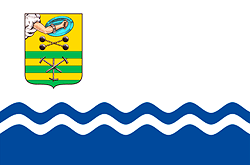
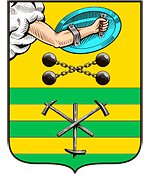
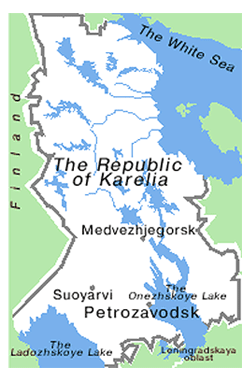



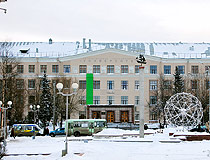
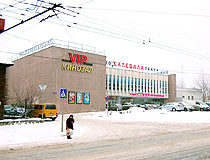
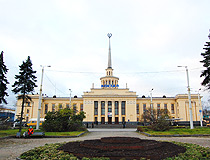
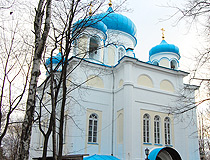
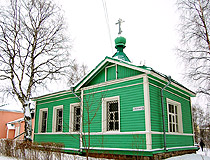
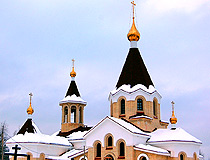
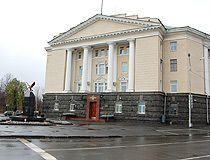
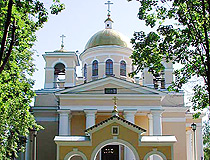
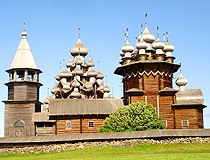
The comments of our visitors